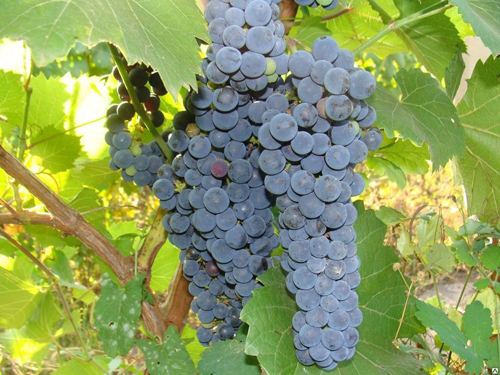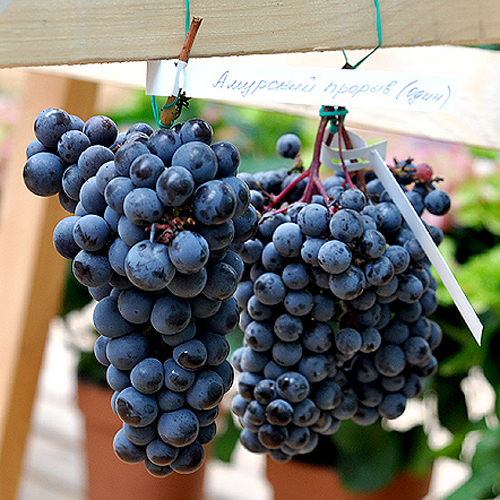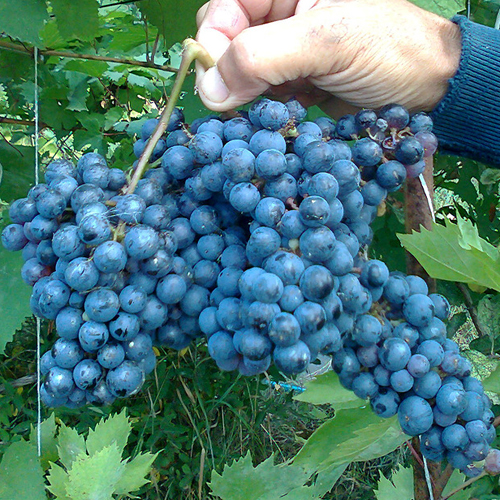Grape variety Amur breakthrough (One)
Huge territories of our country are currently inaccessible for the development of industrial viticulture due to the severity of climatic conditions. The traditional European grape varieties Vitis vinifera, and even its hybrids with the less capricious American varieties, cannot grow there due to the inability to withstand the severe frosts in winter. At the same time, in the Siberian taiga and in the Far East, the local wild species Vítis amurensis (Amur grapes) exists and grows well, which is not afraid of frost, disease, or other hardships of the northern regions. However, from a practical point of view, until a certain time, it did not represent any benefit, since in the wild state its fruits were of little use both for eating fresh and as raw materials for processing.
To change this state of affairs, creating a cultural Russian grape on the basis of the Amur savage, throughout his life tried a famous biologist-breeder, Researcher with a capital letter - Alexander Potapenko, brother of Yakov Ivanovich Potapenko, whose name today bears the All-Russian Research Institute of Viticulture and Winemaking in the city of Novocherkassk.

And the first, most important steps in this direction, Alexander Ivanovich took. Not satisfied with the results of interspecific hybridization with the participation of Amur grapes, in which the genes of its colossal resistance were not properly transferred to the hybrid offspring, he set himself the task of intraspecific selection, that is, in fact, the domestication of the wild form, as happened with other types of grapes thousands of years ago. In this field, he managed to achieve the main thing - to overcome genetic conservatism, transferring the plants at his disposal into a mutable state, making them suitable for successful breeding work aimed at increasing the size of bunches, their quality, taste and technological characteristics while maintaining the inherent qualities of simplicity.
As a result of selection, Alexander Ivanovich was able to multiply the size of a bunch of taiga grapes, having achieved a significant volume of pulp and yield of juice, moreover, in the wild state, almost all the space in the berries was occupied by seeds. During his life, he received many interspecific and intraspecific hybrids with the participation of Vítis amurensis, which have a variety of morphological qualities, but are invariably winter-hardy and disease-resistant. Some of them turned out to be so successful that they were subsequently recognized at the highest level, being included in the State Register of Breeding Achievements. One of these varieties is the Amur breakthrough, or as it is also called - "Potapenko-7" or "One" (with an emphasis on the first letter). It is a purebred cultivated form of Amur grapes, but at the same time in its characteristics it is not much inferior to the technical varieties of the European type, and is even suitable for use as a table variety. In 2018, our hero officially completed the state test, according to the results of which he was approved for use in all regions of the Russian Federation. This event was a real breakthrough in recognizing the titanic work of Alexander Potapenko to create Russian grapes. The only pity is that this significant event, as is often the case with great scientists, took place only when Alexander Ivanovich was no longer alive.
Agrobiological characteristics
The plant is powerful, grows very quickly and reaches gigantic proportions. The leaves are large, rounded, funnel-shaped, five-lobed, slightly dissected, light green in color. The lateral notches are shallow, barely outlined, or V-shaped. The petiole notch is predominantly closed with a rounded lumen, but it can also be open lyre-shaped with a narrow aperture.The leaf blade has a finely bubbly (shagreen) surface, the reverse side is covered with a weak bristly pubescence. The denticles along the edge of the leaf are triangular, uneven in size, with sharp apices and a base of medium width. The flowers of the Amur Breakthrough with a functionally female type of flowering require the presence of a number of bisexual varieties, with the help of which they are perfectly fertilized without requiring additional manual pollination. Ripening of annual shoots is excellent. Young growth has a green color with a reddish tint, which becomes reddish-brown when ripe. The foliage color of the grapes in autumn is also red.

The clusters are above average in size, rather dense, cylindrical-conical, with an average weight of 250-400 grams, but larger specimens also grow. The combs and stems of the berries are short and strong. The berries are quite large, even in size, dark purple in color, rounded, up to 15 mm in diameter and an average weight of 4-5 grams. The pulp is fleshy, juicy, with a harmonious, memorable taste. The color of the juice of the Amur Breakthrough is wine-red. Its yield reaches standard technological values - 70-75%. Sugar content is 24 grams / 100 cubic meters. cm, acidity - 7 grams / cubic dm. The skin is firm, but easily chewed, covered with a layer of a protective wax coating of moderate intensity. As a rule, there is only one stone in a berry, of medium size, it does not have a significant negative effect on taste.
Harvest for universal use. Due to its high sugar accumulation, good ordinary wines are obtained from it. Gourmets, of course, are always ready to criticize a drink made from grapes that are insufficiently noble, in their opinion, however, given the northern growing region, where no classic variety would survive, such nit-picking seems inappropriate. The Amur breakthrough is also good at making juice, compotes, and jam. It is also used for fresh consumption, although it demonstrates less attractiveness in appearance compared to southern large-fruited varieties, but in terms of taste, it is not inferior to them. The tasting score of fresh berries is 8.6 points. The crop is quite transportable, but it does not differ in outstanding storage properties.
The grapes are early ripe. The growing season begins very early and lasts about 110 days until the berries ripen. According to the testimony of amateur winegrowers, Odin manages to ripen without problems in the Moscow region and even more northern regions with the sum of active temperatures of 2000-2200 ° C. And although the Amur Breakthrough is not a record holder by this indicator, since many southern varieties can boast of a shorter growing season, its main advantage is the ability to grow and bear fruit in the north without the laborious procedure of sheltering vines for the winter. Its frost resistance is extremely high and is -35 ... -40 ° С.
The fruitfulness of the shoots is significant. On most of them, several bunches are formed, which, after ripening, can weigh up to one and a half kilograms in total. The total yield is exceptionally high and amounts to more than 200 c / ha per unit area. From a single adult bush, taking into account its ability to grow to a height of 30 meters, up to 100 kilograms of grapes can be harvested. There was no negative impact from overloading the bushes with crops at the Amur breakthrough. After ripening, the bunches can continue to hang on the bushes for a significant period of time, but in the short northern summer this quality is not always in demand. The crop is not damaged by wasps and does not crack due to high soil moisture. Moreover, it is precisely for the constant presence of a sufficient amount of moisture that the variety makes increased demands.In arid regions, it grows weakly and depressed.

Agrotechnical features
When planning the planting of the Amur breakthrough, it is necessary to take into account that this is the northern grape, which is most adapted to cultivation in climatic conditions close to those in which its wild ancestor grew. Attempts to grow it in the south will most likely lead to disappointment for the grower.
For successful cultivation, the variety prefers loose, acidic, well-moistened soils. In places where droughts occur in summer, it is necessary to consider the possibility of watering the grapes during this period. Propagated mainly by layering and cuttings, which take root well, take root and grow very quickly, adding up to 2.5 meters in growth per year. One is practically not damaged by pests and diseases, although some growers still recommend prophylactic spraying against downy mildew (mildew) with copper-containing or other permitted and safe preparations.
They form bushes without shelter for the winter, however, in the most frosty regions, it is recommended to remove the vine from the trellis in the fall so that it can be covered with snow. To do this, it is necessary to shape the bush in accordance with classic covering schemes, such as a multi-arm fan or an inclined cordon. There is a lot of evidence that when the air temperature dropped below critical levels even for the Amur breakthrough, those parts of the plants that were under the snow retained their viability, and very quickly regrowed, restored the entire bush. A similar picture can be traced with spring frosts: when the eyes that have begun to grow in growth are damaged by recurrent frosts, replacement buds are massively awakened, which have not much less fertility. The variety succeeds well in the arbor and arched culture, where it is at the same time an excellent gardener and a highly productive inhabitant of the site. Due to the ability to actively grow almost unlimitedly, grapes are often used for landscaping the facades of multi-storey buildings.
Many growers claim that the variety does not need pruning, since in harsh climatic conditions, the upper part of the shoots inevitably freezes, which, in their opinion, is quite enough to shorten the annual growth. However, when growing on a vertical trellis, this approach is not always justified, since it requires deliberate actions to give the bush the desired shape, and it is pointless to rely on chance. And even where growers decide to take care of this mother nature, sanitary pruning with the removal of frozen parts of the plant is still necessary.
Assessing the Amur breakthrough in terms of a set of characteristics, it should be noted that for its climatic niche it is more than promising, and is in demand now. It is supported by outstanding unpretentiousness, primarily to frost, high productivity, excellent quality of fruits for northern conditions and their universal use. In addition, I would like to believe that the grandiose business started by Alexander Ivanovich Potapenko will be continued, and with the participation of Odin, even more productive and high-quality varieties will be created in the future, and the glory of the harsh Russian grapes will spread throughout the world.








